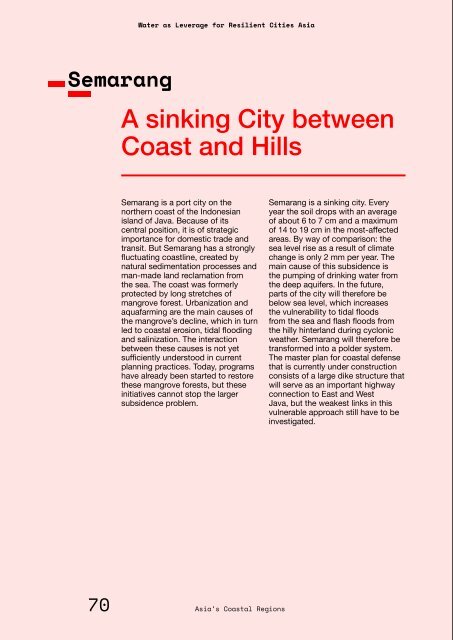Water as Leverage- Setting the scene for a call for action
- No tags were found...
You also want an ePaper? Increase the reach of your titles
YUMPU automatically turns print PDFs into web optimized ePapers that Google loves.
<strong>Water</strong> <strong>as</strong> <strong>Leverage</strong> <strong>for</strong> Resilient Cities Asia<br />
Semarang<br />
A sinking City between<br />
Co<strong>as</strong>t and Hills<br />
Semarang is a port city on <strong>the</strong><br />
nor<strong>the</strong>rn co<strong>as</strong>t of <strong>the</strong> Indonesian<br />
island of Java. Because of its<br />
central position, it is of strategic<br />
importance <strong>for</strong> domestic trade and<br />
transit. But Semarang h<strong>as</strong> a strongly<br />
fluctuating co<strong>as</strong>tline, created by<br />
natural sedimentation processes and<br />
man-made land reclamation from<br />
<strong>the</strong> sea. The co<strong>as</strong>t w<strong>as</strong> <strong>for</strong>merly<br />
protected by long stretches of<br />
mangrove <strong>for</strong>est. Urbanization and<br />
aquafarming are <strong>the</strong> main causes of<br />
<strong>the</strong> mangrove’s decline, which in turn<br />
led to co<strong>as</strong>tal erosion, tidal flooding<br />
and salinization. The inter<strong>action</strong><br />
between <strong>the</strong>se causes is not yet<br />
sufficiently understood in current<br />
planning practices. Today, programs<br />
have already been started to restore<br />
<strong>the</strong>se mangrove <strong>for</strong>ests, but <strong>the</strong>se<br />
initiatives cannot stop <strong>the</strong> larger<br />
subsidence problem.<br />
Semarang is a sinking city. Every<br />
year <strong>the</strong> soil drops with an average<br />
of about 6 to 7 cm and a maximum<br />
of 14 to 19 cm in <strong>the</strong> most-affected<br />
are<strong>as</strong>. By way of comparison: <strong>the</strong><br />
sea level rise <strong>as</strong> a result of climate<br />
change is only 2 mm per year. The<br />
main cause of this subsidence is<br />
<strong>the</strong> pumping of drinking water from<br />
<strong>the</strong> deep aquifers. In <strong>the</strong> future,<br />
parts of <strong>the</strong> city will <strong>the</strong>re<strong>for</strong>e be<br />
below sea level, which incre<strong>as</strong>es<br />
<strong>the</strong> vulnerability to tidal floods<br />
from <strong>the</strong> sea and fl<strong>as</strong>h floods from<br />
<strong>the</strong> hilly hinterland during cyclonic<br />
wea<strong>the</strong>r. Semarang will <strong>the</strong>re<strong>for</strong>e be<br />
trans<strong>for</strong>med into a polder system.<br />
The m<strong>as</strong>ter plan <strong>for</strong> co<strong>as</strong>tal defense<br />
that is currently under construction<br />
consists of a large dike structure that<br />
will serve <strong>as</strong> an important highway<br />
connection to E<strong>as</strong>t and West<br />
Java, but <strong>the</strong> weakest links in this<br />
vulnerable approach still have to be<br />
investigated.<br />
70 Asia’s Co<strong>as</strong>tal Regions<br />
PART 1 / From Global <strong>Water</strong> Issues to a Call <strong>for</strong> Action<br />
71


















